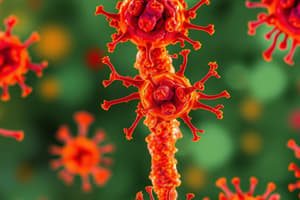Podcast
Questions and Answers
A common type of parasitic worm is ______ spirali.
A common type of parasitic worm is ______ spirali.
Trichinella
Spoilage organisms such as ______ can cause allergic reactions and respiratory problems.
Spoilage organisms such as ______ can cause allergic reactions and respiratory problems.
molds
A common foodborne illness arises from the ingestion of living pathogenic ______.
A common foodborne illness arises from the ingestion of living pathogenic ______.
bacteria
The parasite ______ is commonly found in water contaminated with feces.
The parasite ______ is commonly found in water contaminated with feces.
The single-celled eukaryotes that are parasitic are known as ______ parasites.
The single-celled eukaryotes that are parasitic are known as ______ parasites.
The filamentous structure in which molds grow is called ______.
The filamentous structure in which molds grow is called ______.
The spores that molds replicate through are called ______, which are dispersed through the air.
The spores that molds replicate through are called ______, which are dispersed through the air.
The microorganisms that contribute to the fermentation of foods like bread and wine are often called ______.
The microorganisms that contribute to the fermentation of foods like bread and wine are often called ______.
Spoilage organisms like ______ are often visible, while bacterial spoilage is usually not visible.
Spoilage organisms like ______ are often visible, while bacterial spoilage is usually not visible.
The bacteria ______ can be found in raw or undercooked meat and seafood.
The bacteria ______ can be found in raw or undercooked meat and seafood.
Microbes grow in a range of moisture activity (Aw) between 0.6 and ______
Microbes grow in a range of moisture activity (Aw) between 0.6 and ______
Pathogens can grow at pH levels between 4.6 and ______
Pathogens can grow at pH levels between 4.6 and ______
Bacteria can double in number approximately every ______ minutes under optimal conditions.
Bacteria can double in number approximately every ______ minutes under optimal conditions.
Obligate anaerobes require ______ to survive and cannot tolerate oxygen.
Obligate anaerobes require ______ to survive and cannot tolerate oxygen.
The most common bacteria associated with foodborne diseases are typically ______ forming pathogens.
The most common bacteria associated with foodborne diseases are typically ______ forming pathogens.
HAV, or Hepatitis A Virus, is found in human ______ and contaminated food.
HAV, or Hepatitis A Virus, is found in human ______ and contaminated food.
Norovirus can cause symptoms like vomiting, diarrhea, and ______.
Norovirus can cause symptoms like vomiting, diarrhea, and ______.
Obligate aerobes grow primarily on the ______ of food surfaces.
Obligate aerobes grow primarily on the ______ of food surfaces.
Microbes need optimum ______ conditions for growth, including temperature and nutrient availability.
Microbes need optimum ______ conditions for growth, including temperature and nutrient availability.
Bacterial spores can germinate into vegetative state when conditions become ______.
Bacterial spores can germinate into vegetative state when conditions become ______.
The foodborne illness caused by ingestion of large numbers of live pathogens is known as ______-mediated infections.
The foodborne illness caused by ingestion of large numbers of live pathogens is known as ______-mediated infections.
The primary cause of gastroenteritis in Canada is ______.
The primary cause of gastroenteritis in Canada is ______.
Listeria monocytogenes is resistant to heat, salt, low temperature, and ______.
Listeria monocytogenes is resistant to heat, salt, low temperature, and ______.
Germ study shows that 20% of foodborne illness comes from ______.
Germ study shows that 20% of foodborne illness comes from ______.
The globally applied food safety system is known as ______.
The globally applied food safety system is known as ______.
Cross-contamination can be prevented by proper food ______.
Cross-contamination can be prevented by proper food ______.
Probiotics are live bacteria that are beneficial for ______ health.
Probiotics are live bacteria that are beneficial for ______ health.
A common microbe that produces toxins that cannot be destroyed by cooking is ______.
A common microbe that produces toxins that cannot be destroyed by cooking is ______.
Fermentation is the process of producing acid to discourage growth of pathogenic and ______ organisms.
Fermentation is the process of producing acid to discourage growth of pathogenic and ______ organisms.
The foundation for HACCP is provided by the ______ program.
The foundation for HACCP is provided by the ______ program.
Microorganisms living in the intestines are referred to as the gut ______.
Microorganisms living in the intestines are referred to as the gut ______.
Food left too long at room temperature can lead to ______ multiplication.
Food left too long at room temperature can lead to ______ multiplication.
Natural fermentation involves microbes that are indigenous to the ______.
Natural fermentation involves microbes that are indigenous to the ______.
Cooking must be adequate to prevent ______ in food.
Cooking must be adequate to prevent ______ in food.
CFIA is responsible for food ______ in Canada.
CFIA is responsible for food ______ in Canada.
Flashcards
Optimum external factors
Optimum external factors
Conditions that favor microbial growth in food, such as nutrients and pH.
Nutrient availability
Nutrient availability
Essential nutrients from plants and animals that support microbial growth.
Pathogen pH range
Pathogen pH range
Pathogens can grow at pH levels between 4.6 and 9.0.
Temperature danger zone
Temperature danger zone
Signup and view all the flashcards
Bacterial doubling time
Bacterial doubling time
Signup and view all the flashcards
Oxygen requirement
Oxygen requirement
Signup and view all the flashcards
Water activity (Aw)
Water activity (Aw)
Signup and view all the flashcards
Foodborne viruses
Foodborne viruses
Signup and view all the flashcards
Bacterial spores
Bacterial spores
Signup and view all the flashcards
Non spore-forming pathogens
Non spore-forming pathogens
Signup and view all the flashcards
E. coli
E. coli
Signup and view all the flashcards
Listeria
Listeria
Signup and view all the flashcards
Fermentation
Fermentation
Signup and view all the flashcards
Hyphae
Hyphae
Signup and view all the flashcards
Conidia
Conidia
Signup and view all the flashcards
Mycotoxins
Mycotoxins
Signup and view all the flashcards
Cryptosporidium
Cryptosporidium
Signup and view all the flashcards
Trichinella spiralis
Trichinella spiralis
Signup and view all the flashcards
Food infections
Food infections
Signup and view all the flashcards
Microbial food spoilage
Microbial food spoilage
Signup and view all the flashcards
Food Intoxications
Food Intoxications
Signup and view all the flashcards
Toxin-mediated Infections
Toxin-mediated Infections
Signup and view all the flashcards
Listeria monocytogenes
Listeria monocytogenes
Signup and view all the flashcards
Salmonella
Salmonella
Signup and view all the flashcards
HACCP
HACCP
Signup and view all the flashcards
Microbial Growth Danger Zone
Microbial Growth Danger Zone
Signup and view all the flashcards
GMP
GMP
Signup and view all the flashcards
Probiotics
Probiotics
Signup and view all the flashcards
Prebiotics
Prebiotics
Signup and view all the flashcards
Gut Microbiome
Gut Microbiome
Signup and view all the flashcards
Cross-contamination
Cross-contamination
Signup and view all the flashcards
Starter Cultures
Starter Cultures
Signup and view all the flashcards
PHAC
PHAC
Signup and view all the flashcards
Study Notes
Microbes and Growth Factors in Food
- Microorganisms thrive in optimal external conditions, including nutrient availability, pH, temperature, and oxygen levels.
- Pathogens generally grow best at a pH between 4.6 and 9.0; food is typically acidic, with a pH below 7.
- The "danger zone" (between 4°C and 60°C) encourages rapid bacterial growth.
- Bacteria double every 20 minutes.
- Different types of microbes have varying oxygen requirements: obligate aerobes require oxygen, anaerobes cannot tolerate oxygen, facultative anaerobes can survive with or without oxygen, and microaerophiles require limited oxygen.
- Microbes grow best in foods with an aw (water activity) between 0.6 and 0.85.
- Microbes grow exponentially.
Types of Microbes in Food
- Viruses are transmitted between hosts through food. Some, like HAV, are found in feces, contaminated food, or shellfish; are heat and disinfection resistant and cause liver disease.
- Norovirus is linked to contaminated raw shellfish, oysters, produce, and pre-made foods.
Bacteria in Food
- Bacteria spread through contaminated surfaces and can persist for days to weeks.
- Many cause acute gastroenteritis (stomach flu).
- Some bacteria produce spores that are highly resistant to harsh conditions (e.g., heat, acid).
- Spoilage bacteria destroy the food's quality.
- Certain bacteria are beneficial as probiotics, supporting digestive health.
Yeasts and Molds in Food
- Yeasts spoil food by fermentation but are also used to make cultures (e.g., wine, bread).
- Molds grow through hyphae and produce conidia (spores) that are spread via air; they may cause allergic reactions.
- Moulds and yeasts produce mycotoxins, which are poisonous.
Parasites in Food
- Protozoans (single-celled eukaryotes) like Cryptosporidium can cause gastrointestinal infections through contaminated water.
- Parasitic worms, like Trichinella spiralis, can be found in undercooked meat.
Meat Safety
- Meat must be cooked to an internal temperature of 68°C or higher to kill pathogens.
- Raw, undercooked meat or seafood, or raw fruits/vegetables, are significant sources of harmful bacteria.
Microbial Food Spoilage
- Spoilage is caused by visible molds, non-visible bacteria, and sometimes-visible yeasts that change the appearance and taste of food.
- Food intoxications result from toxins pre-formed by microbes even after cooking.
- Food poisoning occurs from ingestion of large numbers of living pathogens.
- Norovirus, Listeria monocytogenes, Salmonella, and E. coli are common foodborne pathogens. Bacterial infections and intoxications cause symptoms.
Microbial Food Safety Practices
- Good Manufacturing Practices (GMP) ensure hygiene identification, control, and food safety.
- Danger Zone: Rapid bacteria growth at 4-60 degree celsius.
- Proactive measures like cross-contamination prevention (or proper cooking/cooling of food), avoidance of inappropriate food storage, and avoidance of danger zones help prevent foodborne illnesses.
- HACCP: Hazard Analysis and Critical Control Points, a food safety management system.
- PHAC/CFIA are responsible for surveillance and recall of contaminated food.
Food Fermentation and Probiotics
- Fermentation involves using non-pathogenic bacteria to produce acid, preserving food and enhancing its flavor.
- Probiotics are beneficial live bacteria that support digestive health.
- Prebiotics are carbohydrates that feed the probiotics or deliver probiotics in spores.
Studying That Suits You
Use AI to generate personalized quizzes and flashcards to suit your learning preferences.




